Three Schatz Clocks
Schatz 49 Anniversary Clock
Schatz Royal Mariner Clock (1975)
Schatz Ship's Bell Clock (1980)
This page offers tips for repair of a Schatz Royal Mariner ship's bell clock. The principles are the same for other Schatz ship's clocks and similar for Chelsea ship's bell clocks. The sequence for the bells is the same.
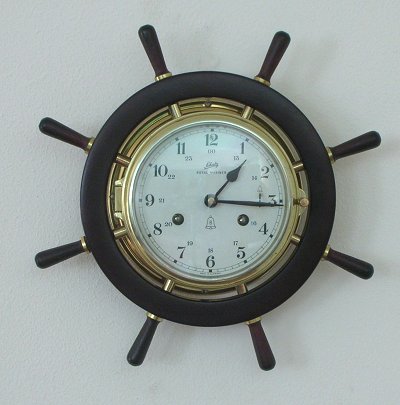 |
 |
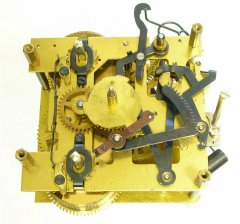 |
Fig. 1
There is not much to see from the back of the clock.
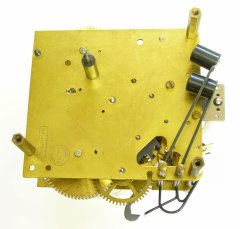 |
Fig. 2
There is a wealth of information in Figure 3 (click on the images to see the enlargements). At the moment the strike lever falls into the recess of the gathering pallet [A], the hammer detent lever rises just as the hammer is released [B]. It is important for the gathering pallet to be adjusted so that striking stops as soon as the last hammer is released, or this feature will not work. The strike gear train is stopped when the strike lever falls to impede the rotation of the warning wheel [C]. There is a cam on the centershaft that determines the position of the hammer detent lever. When the cam raises the lever, this is the half-hour position. Each step on the snail has two positions(the half-hour and the hour). If you compare the half-hour position in Figure 3 and the hour position in Figure 4, this will become clear. I have seen several ship's clocks that were not correctly adjusted because the repairer did not understand it.
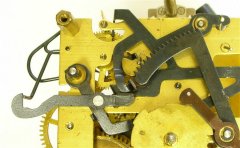 |
Fig. 3
In Figure 4, the hammer detent lever misses because the cam on the centershaft does not raise the lever. This is the hour position.
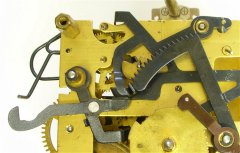 |
Fig. 4
Most of the parts have been removed from the front plate in Figure 5. It shows how the mainspring barrels are installed and how easily the barrels can be removed without taking the entire clock apart.
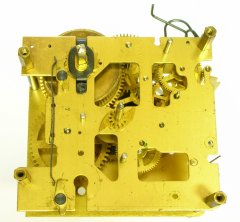 |
Fig. 5
Figure 6 shows the tools used to remove the gathering pallet. It is important that the gathering pallet be pulled upwards and not to one side (the shaft could bend or break).
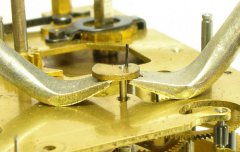 |
Fig. 6
The arrangement of the gears is shown in Figure 7, after the back plate has been removed.
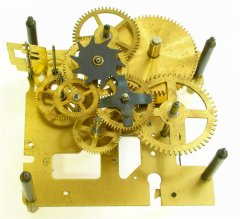 |
Fig. 7
Figure 8 shows the platform escapement of the Schatz Royal Mariner. It has a pin pallet escapement. The most important problem that happens with this platform is that the bushings for the escape wheel wear and need to be rebushed. An improvement would be to install friction jewels to replace the bushings, though the effort may not be justified in an escapement of this quality.
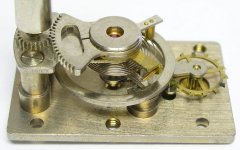 |
Fig. 8
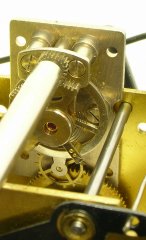 |
Fig. 9
When you compare the Schatz Royal Mariner with a Chelsea ship's bell clock of similar vintage, there are several obvious differences. The Chelsea is better made, with polished pinions and gold-plated brass gears. The Chelsea platform has a Swiss lever escapement with 11 jewels. The Chelsea costs many times more! Chelsea clocks in general are more difficult to work on than Schatz and other equivalent clocks, so repairs on Chelseas should not be attempted by those without at least five years of experience at the bench and some watch repair experience. Schatz clocks are no longer being manufactured, but Chelsea clocks are. Another manufacturer of ship's bell clocks that should be mentioned here is Hermle.

|
The new Hermle ship's bell clocks have platforms with plastic escape wheel and pallets. The plastic parts should never be lubricated because the lubricants may react with the plastic! The second wheel bushing on the front plate of the Hermle is very close to the edge of the plate, making the replacement of the bushing difficult. If you buy a new mechanical ship's bell clock that is not a Chelsea, it probably has a Hermle mechanism.
This Schatz clock was sent from Long Island, NY.
Here is the original instruction manual for your Shatz Royal Mariner.
Clock Repair Main Page
Escapements in Motion
Links Page
Tributes Page